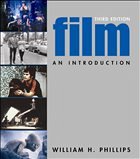The most comprehensive and accessible text of its kind,' Film: An Introduction' combines the universal appeal of movies with the academic rigor instructors require. It includes a wider array of films, more help for students, and a broader selection of images than any other introductory book. Combining up-to-date examples and over 500 images with numerous classroom-tested learning tools and study aids,' Film: An Introduction' helps beginning students develop the critical skills they need to analyze films and understand the medium in all its variety.
From the contents:
PART ONE: THE EXPRESSIVENESS OF FILM TECHNIQUES
Mise En Scene
Cinematography
Editing
Sound
PART TWO: SOURCES AND COMPONENTS OF FICTIONAL FILMS
Sources for Fictional Films
Aspects of Fictional Films
PART THREE: THE VARIETY OF FILMS
Types of Fictional Films
Alternatives to Live-Action Fictional Films
PART FOUR: UNDERSTANDING FILMS
Understanding Films Through Contexts
Thinking About Films
Appendices
A Chronology: Film in Context (1895-2004)
How to Read Film Credits
Illustrated Glossary
From the contents:
PART ONE: THE EXPRESSIVENESS OF FILM TECHNIQUES
Mise En Scene
Cinematography
Editing
Sound
PART TWO: SOURCES AND COMPONENTS OF FICTIONAL FILMS
Sources for Fictional Films
Aspects of Fictional Films
PART THREE: THE VARIETY OF FILMS
Types of Fictional Films
Alternatives to Live-Action Fictional Films
PART FOUR: UNDERSTANDING FILMS
Understanding Films Through Contexts
Thinking About Films
Appendices
A Chronology: Film in Context (1895-2004)
How to Read Film Credits
Illustrated Glossary

